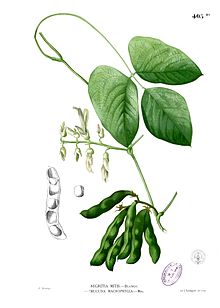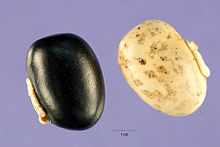Ituck bean
| Ituck bean | ||||||||||||
|---|---|---|---|---|---|---|---|---|---|---|---|---|

Pruritus bean ( Mucuna pruriens ) |
||||||||||||
| Systematics | ||||||||||||
|
||||||||||||
| Scientific name | ||||||||||||
| Mucuna pruriens | ||||||||||||
| ( L. ) DC. |

The pruritus bean ( Mucuna pruriens ) is a type of plant from the subfamily of the butterflies (Faboideae).
description
The pruning bean is an annual (rarely two-year ) left-winding creeper that can reach heights of up to 18 meters. Young individuals are almost completely hairy, but during senescence the plants become almost completely bare.
The leaves are triply pinnate. The petiole has a length between 2 and 40 centimeters. The individual leaflets are between 4.9 and 19 centimeters long and between 3.5 and 16.5 centimeters wide. Your blade is ovate, obovate, diamond-shaped or elliptical. The lateral leaflets are often very asymmetrical, and pointed to pointed. Both leaf sides of the young plants are hairy. The stalks of the leaflets are 2 to 3 millimeters long. The stipules are about 5 millimeters long.
The axillary, paniculate inflorescence is 15 to 32 centimeters long and contains two to three or many flowers. The flower stalks have a length of between 2.5 and 5 millimeters. The bracts are about 12.5 millimeters long. The hermaphrodite flower is zygomorphic . The silky calyx is 7.5 to 9 millimeters long. The calyx teeth are at least as long as the calyx tube. The crown is purple or white. The flag is 1.5 inches long. The boat is between 2.5 and 3.8 centimeters long.
When the fruit is ripe, a 4 to 13 centimeter long, 1 to 2 centimeter wide, wingless legume forms , which is densely covered with brown hair that is very irritating to the bare skin. A longitudinal rib runs on the fruit. The pod contains up to seven seeds . The seeds are flattened ovate to ellipsoidal, 1 to 1.9 inches long, between 0.8 and 1.3 inches wide and 4 to 6.5 millimeters thick. The dry weight of the seeds is 55 to 85 grams per 100 seeds. The hilum , the point of attachment of the funiculus (connection between placenta and ovule ), is surrounded by a distinct aril (fleshy seed coat).
The number of chromosomes is 2n = 20, 22 or 24.
distribution
The pretzel bean originally comes from the East Indies with Kashmir and Sikkim , as well as southern China, Myanmar and the Indochinese Peninsula. It is unclear whether the stocks in the Philippines and Sri Lanka are natural or imported. Today this species is widespread throughout the tropics .
Systematics
Four varieties have been described within the species :
- Mucuna pruriens var. Hirsuta (Wight & Arn.) Wilmot-Dear
- Mucuna pruriens var. Pruriens
- Mucuna pruriens var. Sericophylla (Perkins) Wilmot-Dear
- Mucuna pruriens var. Utilis (Wall. Ex Wight) Baker ex Burck
It was shown that M. p. var. pruriens has a significantly higher genetic variability than the cultivated variety M. p. var. utilis .
The scientific name of the genus Mucuna is derived from the Tupí word mucunan (= pruritus bean, pruritus fiber). The specific epithet pruriens comes from Latin and means itchy .
use
The pruritus bean is widespread as a fodder plant in the tropics . For this purpose, the whole plants are ensiled , dried as hay or the seeds fed as concentrated feed. Pruritus bean silage contains 11 to 23% crude protein and 35 to 40% crude fiber , the dried beans 20 to 35% crude protein and less than 5% crude fiber.
It is also used as a medicinal plant . The seeds are used in Parkinson's patients because of their L-Dopa content . The seeds are also processed industrially for this purpose.
Roasted pruritus beans can serve as a food substitute for coffee. Fresh shoots or beans can also be eaten cooked. To do this, the parts of the plant must boil for at least 30 minutes and soaked in water 48 hours beforehand, otherwise they are toxic to humans. Unprocessed, the bean is also toxic to animals that do not ruminate .
In the wild forms (all varieties except M. p. Var. Utilis ) there is also the fact that the plant hair contains mucunain , which irritates the skin and causes very unpleasant itching. For this reason, they are also used for commercial itching powders , among other things .
In the Ayurvedic medicine of the velvet bean are aphrodisiac effects rumored. It is also said to have hallucinogenic effects, so parts of the plant are occasionally added to Ayahuasca - an intoxicating drink containing DMT and a monoamine oxidase inhibitor .
One study looked at 60 infertile men who were suffering from psychological stress. They consumed the pruritus bean Mucuna pruriens during the examination and had a noticeably lower feeling of stress and more sperm than before. Ingestion stimulated the antioxidant defense system and improved stress management.
toxicology
The ituck bean is poisonous.
Main active ingredients: gallic acid ; a glucoside ; the alkaloids mucunin , mucunadin , prurienin , prurienidin , nicotine , as well as 5 other alkaloids.
Symptoms of poisoning: In frogs , prurienin slows down the heart, dilates blood vessels, lowers blood pressure and stimulates intestinal peristalsis, with the blood pressure being reduced via the release of histamine ( prurienidin also works ). The indole bases cause spasmolysis of the smooth muscles; 5-methoxy-N, N-dimethyltryptamine and the 5-oxy-indole-3-alylamine cause neuromuscular blockage (likewise 3-alkylamine) and in dogs severe respiratory depression , bronchospasm and drop in blood pressure; habituation occurs after repeated doses.
Effects on the skin: The hair immediately causes unbearable itching. If you don't scratch, erythema and small punctiform papules of an edematous character, such as Lipachen urtricatus or Urticaria papulosa , appear after 5–10 minutes . Usually, however, there is scratching in between; the rash is usually localized; occasionally there are widespread eruptions among the workers who work sugar cane fields.
The active pruritic principle is the proteolytic enzyme mucunain .
ingredients
The non-proteinogenic amino acids stizolobinic and stizolobic acid, which were named after the now outdated scientific name of the plant ( Stizolobium hassjoo Piper & Tracy), could be detected in the seedlings of the plant .
These two compounds have so far been found in the panther mushroom ( Amanita pantherina ) and other mushrooms of the genera Amanita and Clitocybe , in addition to prinic bean seedlings . Stizolobic acid is a competitive antagonist at the AMPA receptor .
literature
- SI Ali: Papilionaceae . In: Flora of West Pakistan . tape 100 . Stewart Herbarium, Rawalpindi 1977, p. 238 ( Mucuna pruriens - online ).
- L. Sathiyanarayanan, S. Arulmozhi: Mucuna pruriens Linn. - A Comprehensive Review . In: Pharmacognosy Reviews . tape 1 , no. 1 , 2007, p. 157-162 . [PDF] ( Memento from February 27, 2008 in the Internet Archive )
Individual evidence
Most of the information in this article is taken from the sources given under Literature and Web Links; the following sources are also cited:
- ↑ P. Padmesh, JV Reji, M. Jinish Dhar, S. Seeni: Estimation of genetic diversity in varieties of Mucuna pruriens using RAPD . In: Biologia Plantarum . tape 50 , no. 3 , September 2006, p. 367-372 , doi : 10.1007 / s10535-006-0051-z .
- ↑ Helmut Genaust: Etymological dictionary of botanical plant names . 3. completely revised and exp. Aufl. Nikol, Hamburg 2005, ISBN 3-937872-16-7 , pp. 397, 510 (reprinted 1996).
- ↑ BV Manyam, M. Dhanasekaran, TA Hare: Effect of antiparkinson drug HP-200 (Mucuna pruriens) on the central monoaminergic neurotransmitters . In: Phytotherapy Research . tape 18 , no. 2 , 2004, p. 97-101 , doi : 10.1002 / ptr.1407 .
- ↑ BV Manyam, M. Dhanasekaran, TA Hare: Neuroprotective effects of the antiparkinson drug Mucuna pruriens . In: Phytotherapy Research . tape 18 , no. 9 , 2004, p. 706-712 , doi : 10.1002 / ptr.1514 .
- ↑ GV Joglekar, MB Bhide JH Balwani: An experimental method for screening antipruritic agents . In: British Journal of Dermatology . tape 75 , no. 3 , March 1963, p. 117 .
- ↑ Mucuna pruriens. In: Erowid Mucuna pruriens Vault. Retrieved May 19, 2008 .
- ↑ Shukla, Mahdi, Ahmad, Jaiswar, Shankwar, Tiwari: Mucuna pruriens Reduces Stress and Improves the Quality of Semen in Infertile Men. In: NCBI. PubLMed.gov, December 18, 2007, accessed on November 23, 2019 (en-EN).
- ↑ a b c d e Lutz Roth, Max Daunderer, Kurt Kormann: Toxic Plants - Plant Poisons. Occurrence, effect, therapy, allergic and phototoxic reactions. With a special section about poisonous animals. 6th, revised edition, special edition. Nikol, Hamburg 2012, ISBN 978-3-86820-009-6 .
- ↑ S. Hattori, A. coma Mine: Stizolobic acid: a new amino acid in Stizolobium hassjoo. . In: Nature (London, United Kingdom) . tape 183 , 1959, pp. 1116-1117 .
- ↑ Shiro Senoh, Shoji Imamoto, Yoshiko Maeno, Takashi Tokuyama, Takeo Sakan, Atsushi Komamine, Shizuoi Hattori: α-Pyrone-6-carboxylic acid derivatives. I. Structure of stizolobic and stizolobinic acids, two novel amino acids from Stizolobium hassjoo . In: Tetrahedron Letters . tape 5 , no. 46 , 1964, pp. 3431-3436 .
- ↑ Shiro Senoh, Yoshiko Maeno, Shoji Imamoto, Atsushi Komamine, Shizuo Hattori, Kyohei Yamashita, Masanao Matsui: α-Pyrone-6-carboxylic acid derivatives. IV. Optical resolution and configuration of stizolobic acid, stizolobinic acid, and β- (6-carboxy-α'-pyrone-5-yl) alanine lactam. . In: Bulletin of the Chemical Society of Japan . tape 40 , no. 2 , 1967, p. 379-384 .
- ↑ WS Chilton, Jonathan Ott: Toxic metabolites of Amanita pantherina, A. cothurnata, A. muscaria and other Amanita species. . In: Lloydia . tape 39 , no. 2-3 , 1976, pp. 150-157 .
- ↑ Koshi Saito, Atsushi Komamine, Shinichi Hatanaka: Biochemical studies on nitrogen compounds of fungi. Part 17. Biosynthesis of stizolobic and stizolobinic acids in Amanita pantherina. . In: Journal for Nature Research . 33C, no. 9-10 , 1978, pp. 793-795 .
- ↑ Kimiaki Yamano, Haruhisa Shirahama: Studies on glutamate agonists and antagonists from Clitocybe acromelalga and Amanita pantherina. . In: Tetrahedron . tape 48 , no. 8 , 1992, pp. 1457-1464 .
- ↑ H. Shinozaki, M. Ishida: Stizolobic acid, a competitive antagonist of the quisqualate-type receptor at the crayfish neuromuscular junction. . In: Brain Research . tape 451 , no. 1-2 , 1988, pp. 353-356 .
- ↑ M. Ishida, H. Shinozaki: Excitatory action of a plant extract, stizolobic acid, in the isolated spinal cord of the rat . In: Brain Research . tape 473 , no. 1 , 1988, p. 193-197 .
- ↑ M. Maruyama, K. Takeda: Stizolobic acid on frog spinal cord; possible species dependent activation of excitatory amino acid receptors . In: Comparative Biochemistry and Physiology - Part C Toxicology & Pharmacology . tape 104 , no. 3 , 1993, p. 439-444 .
Web links
- Versatile information on the type. (Engl.)
- Mucuna pruriens. In: Tropical Forages Factsheets . Retrieved October 24, 2010 .
- Mucuna pruriens. In: Dr. Duke's Phytochemical and Ethnobotanical Database . Retrieved October 24, 2010 .
- Mucuna pruriens . In: U. Brunken, M. Schmidt, S. Dressler, T. Janssen, A. Thiombiano, G. Zizka: West African plants - A Photo Guide. Senckenberg Research Institute, Frankfurt am Main 2008.

